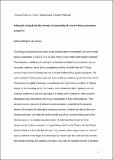Files in this item
Putting the net back into the internet : the materiality of networks from a premodern perspective
Item metadata
| dc.contributor.author | Bildhauer, Bettina M | |
| dc.date.accessioned | 2021-05-18T10:30:03Z | |
| dc.date.available | 2021-05-18T10:30:03Z | |
| dc.date.issued | 2021-05-12 | |
| dc.identifier | 269586914 | |
| dc.identifier | 94a194a0-6dee-466d-80e1-376be0dd5cb3 | |
| dc.identifier | 85164912987 | |
| dc.identifier.citation | Bildhauer , B M 2021 , ' Putting the net back into the internet : the materiality of networks from a premodern perspective ' , Digital Philology: A Journal of Medieval Cultures , vol. 10 , pp. 95-110 . https://doi.org/10.1353/dph.2021.0004 | en |
| dc.identifier.issn | 2162-9544 | |
| dc.identifier.other | ORCID: /0000-0003-1055-9441/work/94291597 | |
| dc.identifier.uri | https://hdl.handle.net/10023/23216 | |
| dc.description.abstract | This essay engages head on with this special issue’s central question—what do medieval things have to tell us about connectivity and object-mediated communication?—by comparing the depiction of nets in medieval sources with our contemporary imaginations of the Internet. The Internet is popularly thought of as immaterial—as wireless and ethereal lines of communication—rather than as pipelines and server villages. While the terms network, Internet, and World Wide Web are modern, nets are among the oldest human technologies. Medieval sources portray them as composed of both material and immaterial elements; as both strings and the gaps between. The elements of a net that are seen as immaterial—the spaces between the strings—are essential to its function. Whether a net is used for carrying, hunting, or decorating, those spaces ensure that prey cannot see it from the outside, that it is stretchable, and that it allows a glimpse into what is within. The material strings are equally essential: they are the elements that capture and hold. Medieval texts and images (for instance, various depictions of Vulcan’s net and Arachne’s net and weft, the German Arthurian romance Daniel of the Blossoming Valley, and the Arabic story collection Kalila and Dimna) emphasize the tension between material and immaterial components by exaggerating the inescapability of the nets from the inside and the invisibility of the nets from the outside. They also stress the nature of nets as traps rather than connectives and use them as metaphors for narratives, much as network analysis uses nets as metaphors for a variety of structures and areas of knowledge. In this essay I suggest returning to a notion of nets, including the Internet, as material, as a corrective to current perceptions. I also argue that the fear of nets as traps might persist in modern imaginations of the Internet. | |
| dc.format.extent | 15 | |
| dc.format.extent | 308084 | |
| dc.language.iso | eng | |
| dc.relation.ispartof | Digital Philology: A Journal of Medieval Cultures | en |
| dc.subject | D111 Medieval History | en |
| dc.subject | P Philology. Linguistics | en |
| dc.subject | T-NDAS | en |
| dc.subject.lcc | D111 | en |
| dc.subject.lcc | P1 | en |
| dc.title | Putting the net back into the internet : the materiality of networks from a premodern perspective | en |
| dc.type | Journal article | en |
| dc.contributor.institution | University of St Andrews. German | en |
| dc.contributor.institution | University of St Andrews. St Andrews Institute of Medieval Studies | en |
| dc.identifier.doi | 10.1353/dph.2021.0004 | |
| dc.description.status | Peer reviewed | en |
| dc.date.embargoedUntil | 2021-05-12 |
This item appears in the following Collection(s)
Items in the St Andrews Research Repository are protected by copyright, with all rights reserved, unless otherwise indicated.

